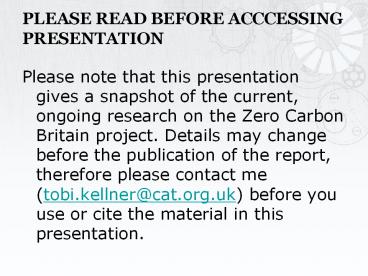PLEASE READ BEFORE ACCCESSING PRESENTATION - PowerPoint PPT Presentation
Title:
PLEASE READ BEFORE ACCCESSING PRESENTATION
Description:
PLEASE READ BEFORE ACCCESSING PRESENTATION Please note that this presentation gives a snapshot of the current, ongoing research on the Zero Carbon Britain project. – PowerPoint PPT presentation
Number of Views:111
Avg rating:3.0/5.0
Title: PLEASE READ BEFORE ACCCESSING PRESENTATION
1
PLEASE READ BEFORE ACCCESSING PRESENTATION
- Please note that this presentation gives a
snapshot of the current, ongoing research on the
Zero Carbon Britain project. Details may change
before the publication of the report, therefore
please contact me (tobi.kellner_at_cat.org.uk)
before you use or cite the material in this
presentation.
2
Future Energy Networks Modelling Supply And
Demand in a Renewable Energy Future Tobi
KellnerCAT
3
Quick Introduction
- I am a renewable energy consultant researcher
at the Centre for Alternative Technology (CAT)
in Machynlleth, Wales - CAT is an education research centre established
1973
4
About ZCB 2030
- Aims
- Show that a future with 100 renewable energy
zero (net) GHG emissions is physically possible - Stimulate debate, shift goal posts
5
Modelling Why?
Modelling Future Energy Systems Why?
6
Modelling Why?
Todays Energy System
DECC UK Energy Flow Chart 2011
7
Modelling Why?
Todays Energy System
Gas
Industry
Coal
Transport
Domestic
Oil
DECC UK Energy Flow Chart 2011
8
Modelling Why?
Todays Energy System
Gas
- Todays energy system
- Is heavily dependent on finite fossil fuels with
high GHG emissions - Has grown evolved over many decades
Coal
Oil
9
Modelling Why?
Todays Energy System
Gas
- Tomorrows energy system
- Radical changes in supplyUncontrollable
renewables(and/or inflexible nuclear) - Radical changes in demandElectrification of
heating transport - No time for trial error evolution!
Coal
Oil
10
Modelling How?
Modelling Future Energy Systems What?
11
Modelling What?
Parameter Options ZCB choice
Spatial system boundaries Single region? UK? Europe? UK(not Britain...)
Interaction with outside Interconnectors?Imports/exports? None(island system)
Spatial resolution Model individual regions flows between them? Treat UK grid as a single point, copper plate UK
Temporal resolution Year? Day? Hour? Millisecond? 1 hour
12
Modelling How?
Modelling Future Energy Systems How?
13
Modelling How?
ZCB energy model
SupplyModel
Demand Model
14
Modelling How?
ZCB energy model
- For the ten years 2002-2011 (87,648 hours), we
have - Hourly data on offshore onshore wind speeds,
solar radiation, wave heights - Hourly electricity consumptionfrom National Grid
- Daily weighted temperatures from National Grid
15
Modelling How?
ZCB energy model
- Use real historic data or synthesise from
statistical model? - Potentially complex interactions ? synthetic
model would be very complex - Is historic data plausible basis for future
model?
16
(No Transcript)
17
Offshore Wind
Example Hourly model for offshore wind power
18
Offshore Wind
- Offshore wind Strongest UK renewable energy
source - Need to model output of widely distributed future
wind farm fleet - Problem Almost no historic measured offshore
wind speed data
Heat pumps
Offshore wind
19
Offshore Wind
MERRA
- Solution NASAs MERRA (Modern-Era Retrospective
Analysis for Research and Applications), a kind
of weather back-cast - Hourly data for past decades, 0.5 spatial
resolution
20
Offshore Wind
Validation
- Validation compare MERRA to real offshore wind
data, e.g. half-hourly readings from helipad at
Ekofisk oil field
21
Offshore Wind
Validation
22
Offshore Wind
Validation
23
Offshore Wind
Methodology
- Approach Define regions for fixed floating
offshore wind farms - Assign capacity (in GW) for each region
- Get hourly wind speeds calculate hourly power
output for each region
24
Offshore Wind
Methodology
25
Complete model
Bringing it all togetherThe Hourly Energy Model
26
Hourly energy model
27
Hourly energy model
gt90GW excess supply available
gt60GW dispatchable backup required
28
Hourly energy model
of time level is exceeded
29
Short term variation
- Large hour-to-hour fluctuations, dominated by
heat demand - Demand Side Management (DSM) can help, e.g.
smart charging of electric cars - Pumped hydro storage and heat storage can
provide short term storage (a few 100GWh)
30
Hourly energy model
31
Long term variation
32
Long term variation
- Significant longer-term variation between months
years - Ideally many TWh of storage
33
Backup storage
- Flexible dispatchable storage backup is still
required - Gas allows storage of large quantities of energy
(100s of TWh) - Gas turbines allow flexible dispatch, proven
technology
34
Backup storage
- Hydrogen can easily be created from renewable
electricity (electrolysis) - But natural gas (methane) is easier to store and
we have vast existing infrastructure - The Sabatier reaction allows methanation of
hydrogen
35
Sabatier reaction
source Sterner (2010)
Sabatier CO2 4H2 ? CH4 2H2O
36
Long term gas storage
37
The Future Integrated Energy Networks
Variablegeneration
SyntheticH2 / CH4Production
ElectricityGrid
Central Heat Pumps
Gas Storage
Heat Storage
Heat Networks
GasGrid
Dispatchable generation
CHP (maybe?)
38
- The easy part
- Hourly model of energy supply
- The tricky part
- Model of interaction between price, demand,
storage and backup
39
Thank You Very Muchtobi.kellner_at_cat.org.uk































